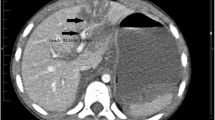Abstract
Eight children with pancreatic injuries after blunt abdominal trauma are presented. One patient with pancreatitis without complications was treated successfully with medication; seven (87.5%) developed pseudocysts, which resolved spontaneously with conservative treatment in four cases (57.1%). Non-resolving pseudocysts in 3 patients finally required surgical intervention. Pseudocysts that resolve spontaneously and those that require surgical intervention can be distinguished. The two groups showed different time sequences in both serum amylase values and pseudocyst size. Analyses of these clinical data revealed three factors with significant predictive value. On the basis of these findings, a new management strategy for traumatic pancreatic pseudocysts in children is proposed. The cyst is likely to resolve spontaneously in cases showing any two or more of the following factors: (1) cyst presentation after day 6; (2) maximum serum amylase below 1,600 IU/l; and (3) serum amylase below 600 IU/l on day 20. However, early surgical intervention is required in the presence of two or more of the following: (1) cyst presentation before day 4; (2) maximum serum amylase above 1,900 IU/l; or (3) serum amylase above 1,200 IU/l on day 20.
Similar content being viewed by others
References
Bass DH, Lakhoo K (1991) Pancreatic injuries in children. S Afr J Surg 29: 39–40
Bass J, Lorenzo MDi, Desjardins JG, Grigton A, Ouimet A (1988) Blunt pancreatic injuries in children: the role of percutaneous external drainage in the treatment of pancreatic pseudocysts. J Pediatr Surg 23: 721–724
Becmeur F, Dhaoui R, Rousseau PH, Heintz C, Leculee R, Bientz J, Sauvage P (1993) Post-traumatic pancreatic pseudocyst: non-operative conservative management — report on 3 cases. Eur J Pediatr Surg 3: 302–305
Dahman B, Stephens CA (1981) Pseudocysts of the pancreas after blunt abdominal trauma in children. J Pediatr Surg 16: 17–21
Ford EG, Hardin WD Jr, Mahour GH, Woolley MM (1990) Pseudocysts of the pancreas in children. Am Surg 56: 384–387
Gorenstein A, O'Halpin D, Wesson DE, Daneman A, Filler RM (1987) Blunt injury to the pancreas in children: selective management based on ultrasound. J Pediatr Surg 22: 1110–1116
Gothi R, Bose NC, Kumar N (1993) Case report: ultrasound demonstration of traumatic fracture of the pancreas with pancreatic duct disruption. Clin Radiol 47: 434–435
Graham JM, Pokorny WJ, Mattox KL, Jordan GL Jr (1978) Surgical management of acute pancreatic injuries in children. J Pediatr Surg 13: 693–697
Grosfeld JL, Rescorla FJ, West KW, Vane DW (1989) Gastrointestinal injuries in childhood: analysis of 53 patients. J Pediatr Surg 24: 580–583
Jeffrey RB Jr, Federle MP, Crass RA (1983) Computed tomography of pancreatic trauma. Radiology 147: 491–494
Ohno Y, Ohgami H, Nagasaki A, Hirose R (1995) Complete disruption of the main pancreatic duct: a case successfully managed by percutaneous drainage. J Pediatr Surg 30: 1741–1742
Robey E, Mullen JT, Schwab CW (1982) Blunt transection of the pancreas treated by distal pancreatectomy, splenic salvage and hyperalimentation. Four cases and review of the literature. Ann Surg 196: 695–699
Roche BG, Bugmann PH, LeCoultre C (1992) Blunt injuries to liver, spleen, kidney and pancreas in pediatric patients. Eur J Pediatr Surg 2: 154–156
Sivit CJ, Eichelberger MR, Taylor GA, Bulas DI, Gotschall CS, Kushner DC (1992) Blunt pancreatic trauma in children: CT diagnosis. Am J Roentgenol 158: 1097–1100
Smith SD, Nakayama DK, Gantt N, Lloyd D, Rowe MI (1988) Pancreatic injuries in childhood due to blunt trauma. J Pediatr Surg 23: 610–614
Sukul K, Lont HE, Johannes EJ (1992) Management of pancreatic injuries. Hepatogastroenterology 39: 447–450
Vane DW, Grosfeld JL, West KW, Rescorla FJ (1989) Pancreatic disorders in infancy and childhood: experience with 92 cases. J Pediatr Surg 24: 771–776
Author information
Authors and Affiliations
Rights and permissions
About this article
Cite this article
Ohno, Y., Ohgami, H., Nagasaki, A. et al. Management of traumatic pancreatic pseudocysts in children. Pediatr Surg Int 11, 326–328 (1996). https://doi.org/10.1007/BF00497804
Accepted:
Published:
Issue Date:
DOI: https://doi.org/10.1007/BF00497804




